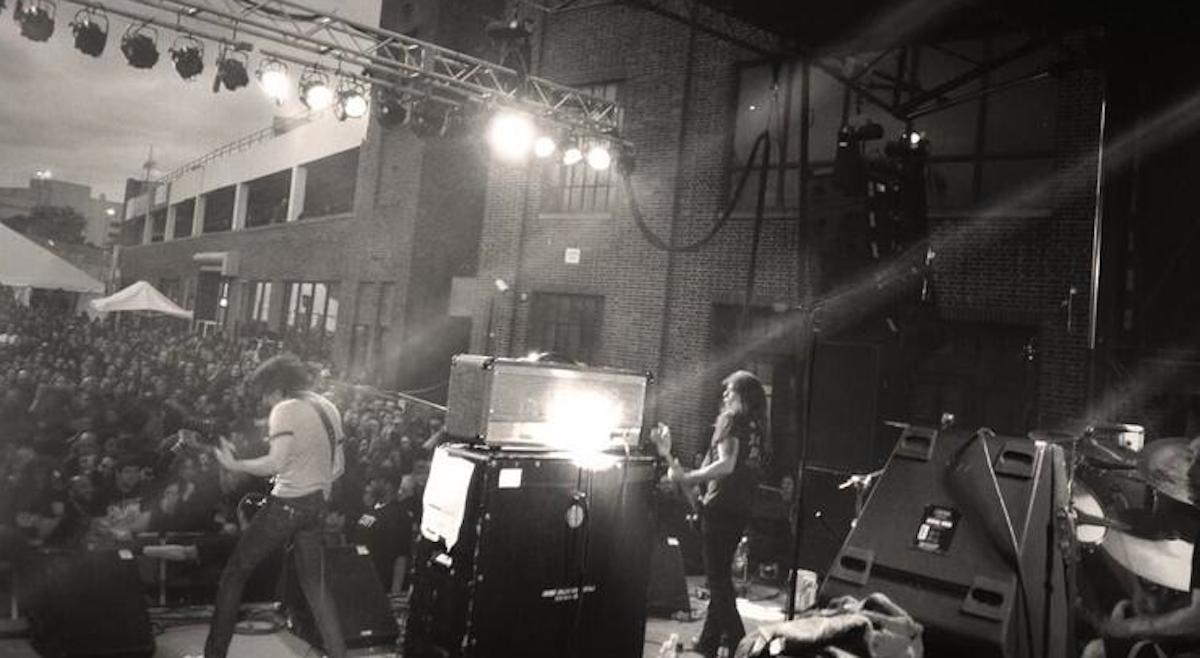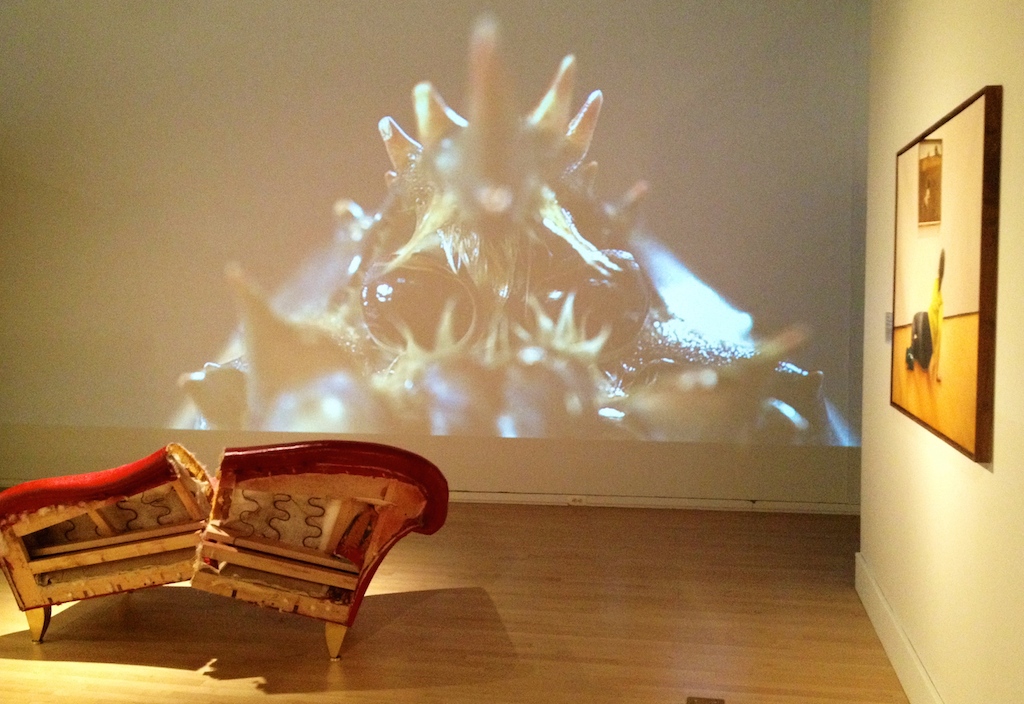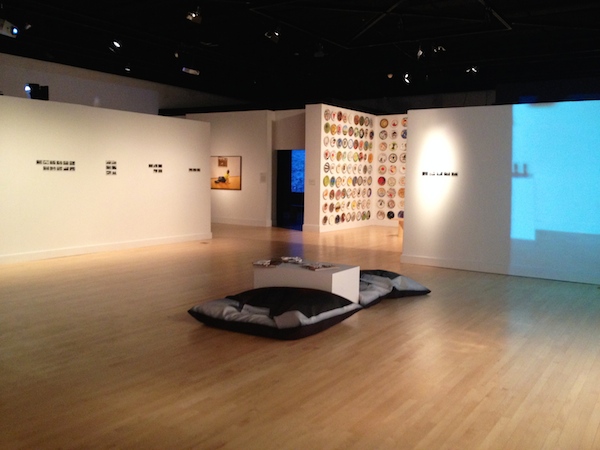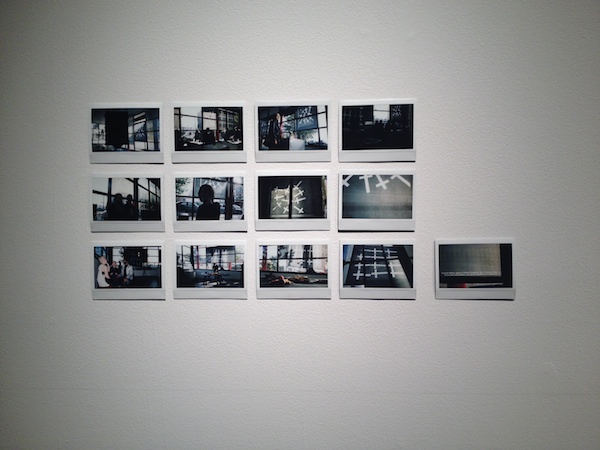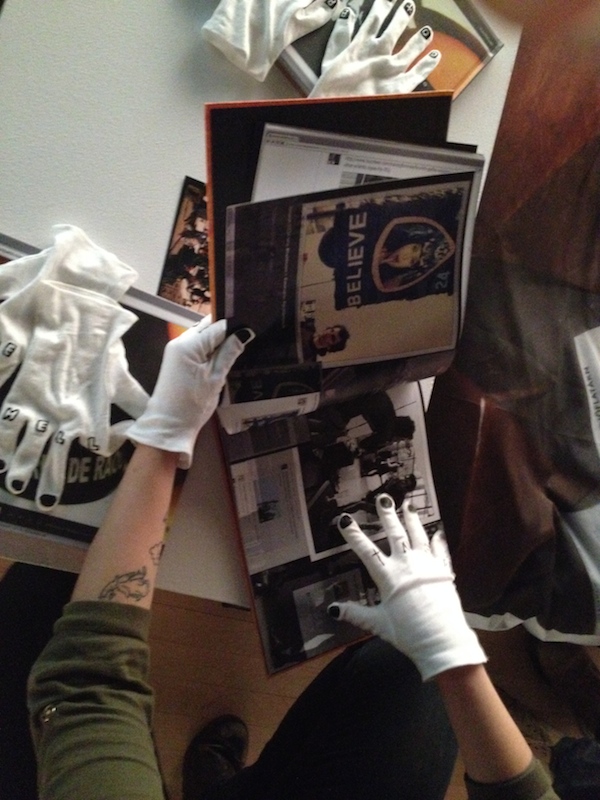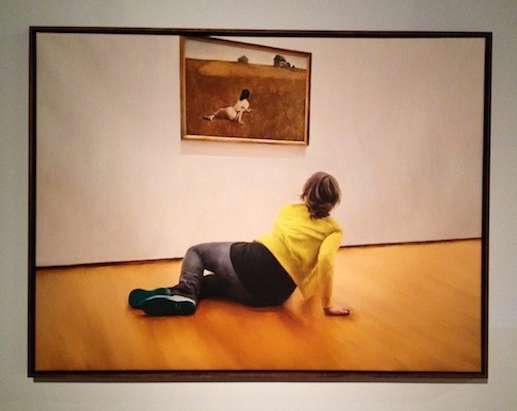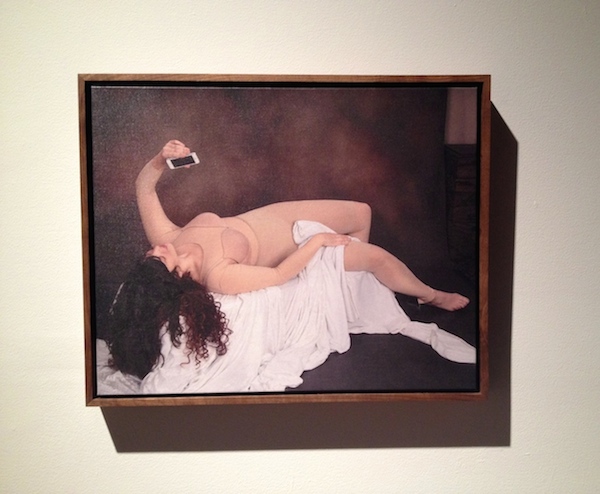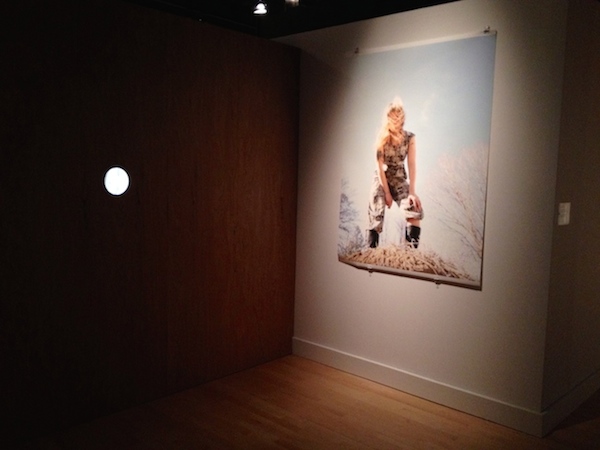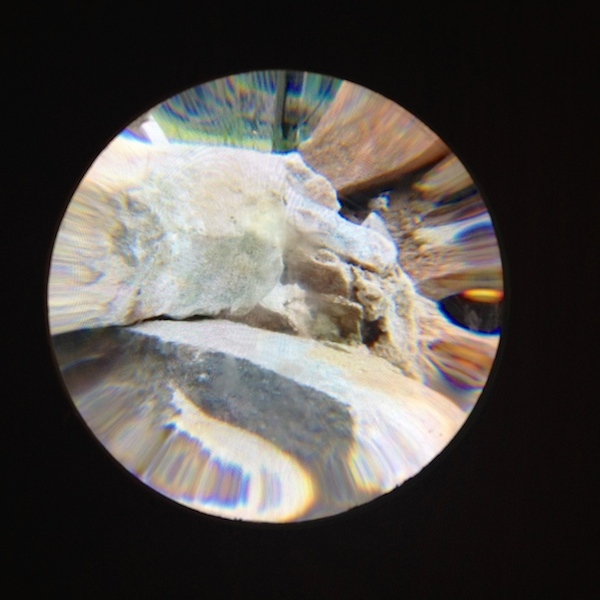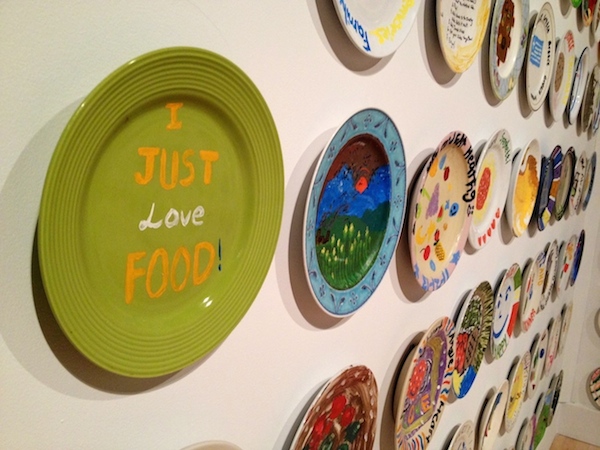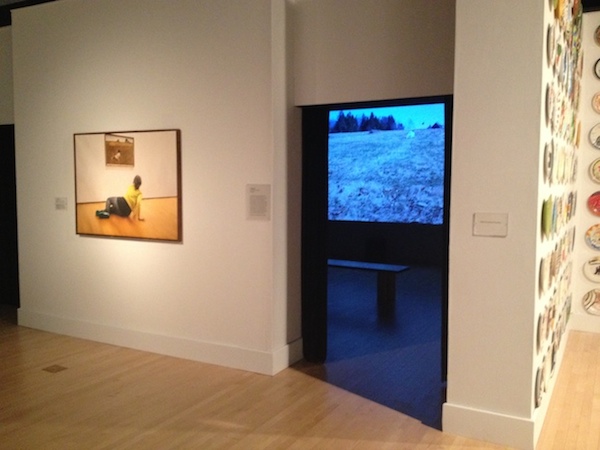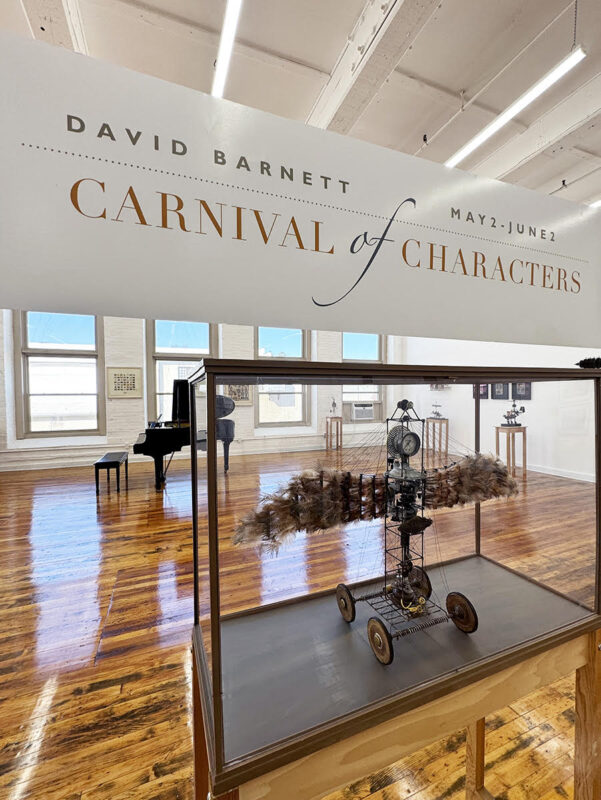UMBC Center for Art, Design, and Visual Culture MFA Thesis Exhibition 2014 in Imaging and Digital Arts
The giant crustacean stares at me beseechingly. One of his eyes shifts, looking for an escape route. The other eye stares at me, pensively. He towers over me in a six-foot tall video cropped to include only his eyes, which are the size of bowling balls. The gallery text reveals that he is a lobster.
Rather than seeming monstrous, his immense size humanizes him. When his eyes independently blink and quiver, it’s obvious that he is nervously awaiting his fate. Forced to examine him up close, I empathize with this lobster. I have enjoyed a number of lobster rolls in the past, but this was before I gazed into a lobster’s soul. Like the best Hollywood movie stars, his understated performance on the big screen has forever changed the way I view lobsters. Days later, I still can’t get him off my mind.
The lobster video is part of the 2014 MFA Thesis Exhibition at the Center for Arts and Visual Culture at University of Maryland Baltimore County, which was up through May 1. It should be noted that UMBC’s three year MFA Program is distinct from others in the area because it only grants degrees in Imaging and Digital Art.
Like the term ‘imaging,’ which is rife with a newish and vague potential, the six students – Michael Farley, Charlotte Keniston, Lexie Mountain, Shana Palmer, Carrie Rennolds, and Dominique Zeltzman – all utilize modern media and digital process professionally, dramatically, and effectively. What is refreshing about this work is the way all six artists are able to seamlessly blend new media with traditional, hands-on process to present varied, personal, and physical results.
As you would expect from a MFA Thesis in Digital Media, the vast CACVC gallery offers a lot of large video projections, which were all were functioning perfectly when I visited. Many of these videos are projected at a cinematic size onto gallery walls to achieve maximal results. A few other videos are smaller to create intimate viewing experiences, and this decision seemed intentional, rather than dictated by space or lack of equipment. In addition to the variety of projection modes, a surprising amount of ‘low tech’ materials are present, like hand painted ceramics, Polaroids, collage, found objects, and a couch that had been chain-sawed in half during an opening reception performance.
Sadly, with many new media exhibits, the emphasis on technology creates barriers to communication. This often includes aggressive, non-verbal sound, curtained-off dark rooms, and work that deals with theoretical aspects of technology. Although there are a few darkened areas of the gallery at UMBC and one set of gold-fringed curtains, the emphasis on technology is highly nuanced and constrained to positive effect. In general, good design occurs when it doesn’t draw attention to itself, in order to place the focus where it should be – on the content. I was pleased that the artists in this exhibit were able to effectively utilize a range of video and digital technologies within a contemporary art gallery context, but without overwhelming their ideas or message.
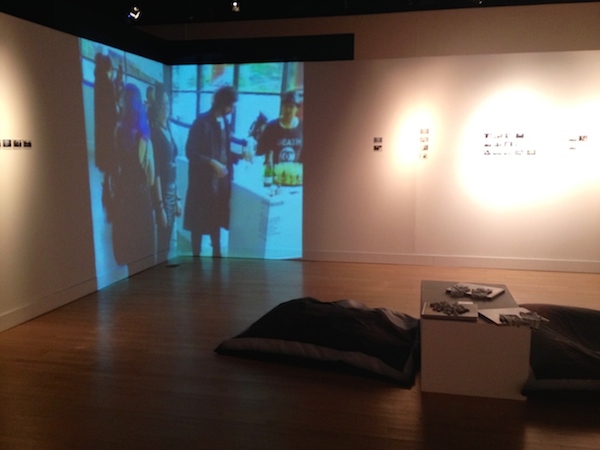
For example, the centerpiece of Michael Farley’s thesis, ‘Goth Bruch,’ is a grainy video featuring footage from several events Farley hosted at Gallery CA, also called Goth Bruch. Projected floor to ceiling in the center of the gallery so that figures are larger than life, the footage shows Farley and other participants dancing, drinking, and hanging out, while wearing 1980’s punk-inspired fashion. A grid of small Polaroid images lines the walls of the space to present additional documentation of the event, but more importantly, offers strong evidence that choice in media affects and alters the message.
Farley also includes several Goth Brunch books on a coffee table, complete with the white viewing gloves customary for handling printed materials in a gallery. Farley’s gloves reinforce the punk aesthetic: they have black fingernails with text. Absurd and low-tech, the different glove pairings reflect nostalgia for Goth style without its typical angst – participants are invited to try them on, and this includes them in the fun.
The books, designed and printed online, provide yet another form of documentation and include printed Facebook feeds, online conversations, photos, and commentary in a clean design. Although it all boils down to one of art’s basic conundrums – nostalgia and the subjectivity of documentation and memory – Farley’s combination of video, photos, and books come together to compellingly present a past event, and utilize technology as an effective tool for documentation while simultaneously recognizing its limitations.
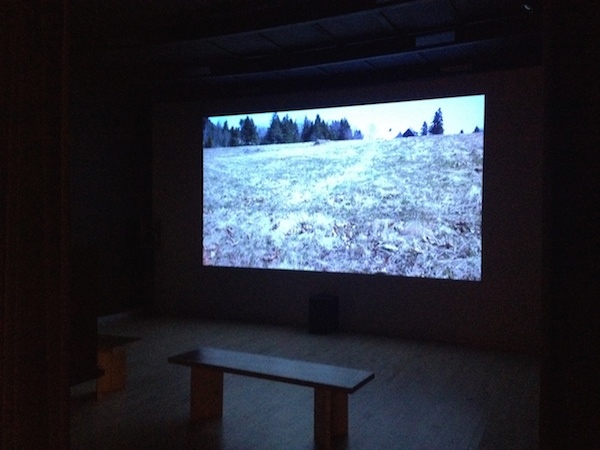
In a nearby gallery, Lexie Mountain questions commonly held perceptions about art history and, specifically, the male artist’s gaze upon female models. And lobsters. In a black box theater, a familiar scene unravels: Andrew Wyeth’s ‘Christina’s World’ comes to life as a woman drags herself by the arms across a Maine field towards a barn, with her legs hanging limply behind her.
In the adjoining gallery, Christina, dressed in modern clothes, lies supine on a gallery floor in her familiar position, while looking up at the original painting on the wall. Closer inspection reveals both are works by Lexie Mountain and both versions develop Wyeth’s iconic view of the mysterious model through newly available technologies. In the video, Mountain portrays the paraplegic, and travels slowly through the model’s implied sight line – from the bottom left corner of the screen to the top right corner and out of view. In literally completing the action depicted in the painting and showing how awkward it all is, the video contrasts mightily with the visual romanticism in the original painting.
Mountain plays Christina again in a ‘painted’ version of the reenactment, gazing up at the painting on a museum wall from her familiar mermaid-like pose. The image, which is actually a digital print created by SNAPPY CANVAS, an online site where you can upload a photo and print it with squishy ‘impressionistic’ marks onto badly stretched canvas. The piece is humorous but posits the central question of contemporary art – What is art? Is this art? Because the piece was cheaply crafted in a highly accessible way, the ideas presented are more powerful. In this case, media and content are one.
In addition to Wyeth’s Christina, Mountain posed as Courbet’s ‘Woman with a Parrot,’ wearing a full body suit of nude colored shapewear. In Mountain’s version, titled ‘Woman with iPhone,’ she appears naked from a distance with a white sheet obscuring her lower body, as she gazes languorously up at her phone. The image, also softened and printed in a “gallery wrap” process onto canvas, becomes more interesting when you realize it was shot in an actual JC Penny portrait studio.
Mountain’s most emotional work, the lobster video projected at a giant scale on the gallery wall, veers radically from feminism, technology, and the male gaze, but it does at least tangentially relate to art history through Vanitas Still life painting from the 16th century. Through a stunningly simple process – select, crop, and enlarge – the artist manages to present an image that is oddly emotional, curious, and disturbing. The artist admits that she ate the lobster after filming it, but that watching the video inspired mini pangs of guilt.
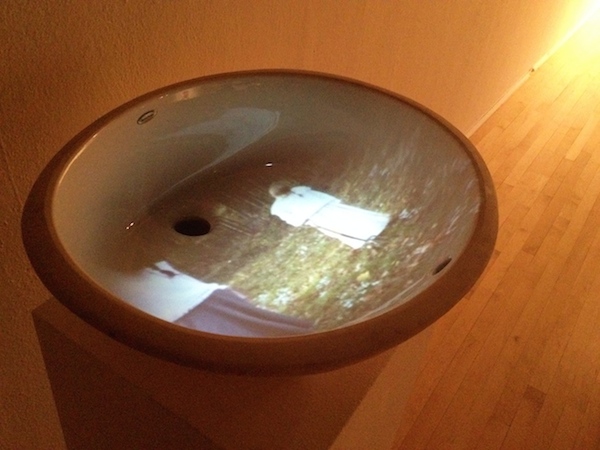
In the next gallery, Shana Palmer embeds video in a number of novel, physical ways. In ‘Unbinding Charm,’ the film is projected from the ceiling onto a white ceramic sink basin. This readymade screen functions better than you would expect, especially since the video lines up perfectly with the edges of the sink and you are forced to peer into its concave surface to view it. This unusual fusion of video and sculptural object creates a whole new world of options for viewing and receiving information.
In Palmer’s ‘Moving Mountains,’ you peer through a small, plastic peephole in a darkened room to view a close-up view of rocks that appear still, but move at a glacial pace if you watch long enough. Both the peephole and the sink basin code the artist’s videos in subtle ways, enriching the content of the narrative. In addition, they make you aware that a neutral screen for viewing video is actually loaded with associations and subjectivity.
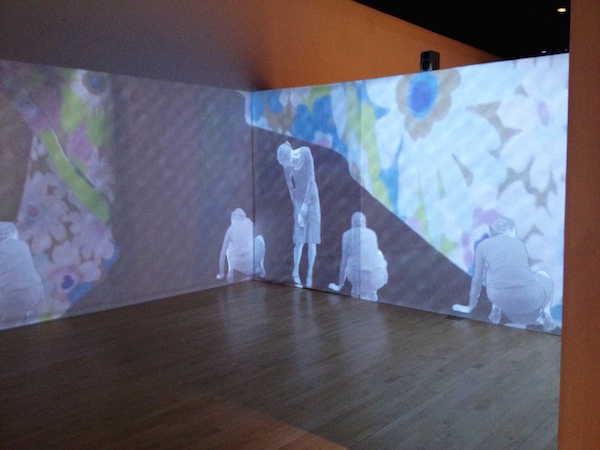
Dominique Zeltzman is the only artist in the group whose thesis is completely digital, without including physical objects, but it is projected on multiple gallery walls to create an immersive digital environment. Looming larger than life, in ‘Radical Home Installation’ a hunched female figure, depicted in varying gray multiples, tiptoes, creeps and crawls painstakingly along the edge of the gallery wall, heading for a Baltimore rowhouse covered in formstone. In the background, varying landscapes, patterns, and home cleaning supplies create an abstract domestic landscape. Her journey occurs slowly, in fits and starts and it’s unclear whether destination is ever reached.
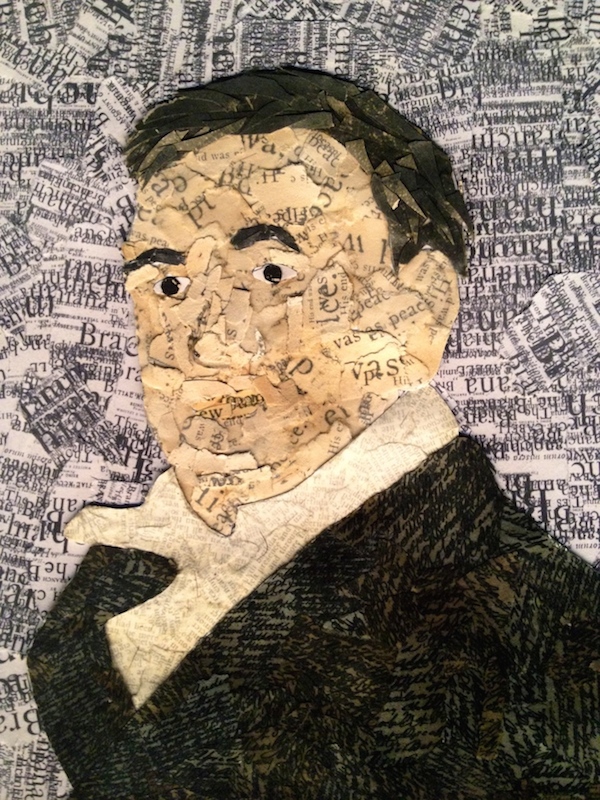
Carrie Rennolds explores an extensive family history, including wealth and an estate gained in part from owning slaves in the 1800’s. The artist creates digital collaged portraits from historical family documents that have been scanned and enlarged. From a distance, the collages brim with a middle school cartoon aesthetic, where features are simplified and flattened into traditional male ‘power portraits.’ Artist-compiled wall texts next to each portrait list quotes, recollections, and legal information about each man, and serve as a key to the the image: the artist used specific texts for different parts of the compositions.
Wall text also helps the viewer to appreciate the vast difference between the quotes about Thomas Branch (1802-1888), like “Nature cast him into a positive mould” and “The consequence was he became a man of results” and the shocking list of the names of his slaves from auction logs. Although most families choose to selectively forget the history that make them uncomfortable, Rennolds mines it in order to create her own; a more honest depiction of her ancestors. An accompanying work features the women of the family, with their portraits obscured behind red velvet curtains that must be moved aside to view.

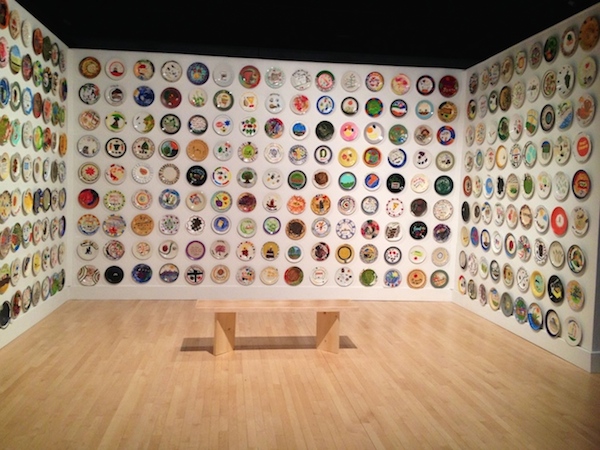
Although Charlotte Keniston’s main thesis piece is a floor to ceiling installation of hand painted dinner plates of varying size and color, she documents the painting experience in an accompanying video. For her thesis, Keniston invited 300 Baltimore City residents who had been affected by “food issues” to participate in workshops to explore what food means for their families and communities, where each created a personal food story on a plate. After the workshops, all the participants and their families were invited to a meal. The result, an accumulation of almost 300 plates, hung on three gallery walls from floor to ceiling is striking from a distance. Up close, you have the opportunity to experience a range of expressions and ideas from “I just love food!” to “The Last Supper!” and stick people sitting around a table. The video, available on a monitor on an opposite wall, served to deepen the story and to help viewers appreciate not just the dazzling accumulation of colorful plates but to appreciate the individuals who created them.
Although the word ‘image’ has existed in the common vernacular for centuries, the term ‘imaging’ is rather new. If it is a verb, as its last three letters suggest, what does it mean, to image? Although it’s close to the word imagine, both in articulation and meaning, imaging, the verb, suggests a fait acompli, rather than a theoretical idea or a picture. What are the options and strategies for imaging? And does this actualization of a visual idea present new opportunities for artistic expression beyond labels of media and style?
I am not sure how the students and faculty from The Imaging and Digital Arts MFA Program at UMBC would respond to this query, but I am convinced that their emphasis on image, also known as message or content, is central to their students’ success in utilizing digital media. As media and technology continues to combine, seamlessly, with our lives, it makes sense for MFA students to employ these tools professionally and creatively to strengthen their message. What’s reassuring about this particular show is the effortless, yet thoughtful, balance between formal and conceptual concerns and digital process, a sign that this group is well prepared for the larger art world.
* Author Cara Ober is the Founding Editor at Bmoreart
